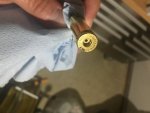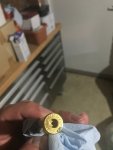After some advice, to what may be a silly question, but I have not come across it before!
So my reloading experience has so far involved Tikka T3s in 223 and 308, reloading for both using Lapua Brass, and no problems on about 6 firings (223) and 10 (308).
After firing a case I deprime, throw them in the SS tumbler to clean and then I will check the length/chamber the empty cartridge to check it chambers well and doesn't have a stiff bolt.
usually this is all fine and I necksize using a collet die. If they don't chamber easily or are too long, I will full length size them and trim. Either way I then chamfer as required, prime, throw powder and seat the bullet. Never a problem.
So I bought a new AI AT with a 6.5 Creedmoor barrel. I have done some load development and have settled on one that is quite some way back from showing any pressure signs. Velocity and accuracy are good.
So my brass is new Lapua, small primer stuff. I have 100 cases once fired. During my normal reloading prep I deprimed and cleaned them, and then measured/chambered them.
Now the case length is fine, below the trim length - all good.
When I chamber the empty case however, there is no stiffness to the bolt closing, all good.
However I am seeing some 'swipe marks' on the base of the case, which is taking material off (can clearly see it's brighter than the rest of the case). I am assuming this is being caused by the ejector during the bolt opening/closing. It is causing slight material loss (tiny brass flakes on the bolt face).
This is concerning me somewhat, am I right to be worried?
The rifle now has about 100 rounds though is, maybe it's just a stuff ejector spring marking them? I am concerned it may be a headspace problem (too little?), but other observations don't tie up for that (and the 6.5CM barrel was checked with go/no go gauges when I picked it up at the same time as I bought the rifle).
I was hoping someone can give some advice anyway as I haven't come across this before in all my reloading for my previous rifles!
So my reloading experience has so far involved Tikka T3s in 223 and 308, reloading for both using Lapua Brass, and no problems on about 6 firings (223) and 10 (308).
After firing a case I deprime, throw them in the SS tumbler to clean and then I will check the length/chamber the empty cartridge to check it chambers well and doesn't have a stiff bolt.
usually this is all fine and I necksize using a collet die. If they don't chamber easily or are too long, I will full length size them and trim. Either way I then chamfer as required, prime, throw powder and seat the bullet. Never a problem.
So I bought a new AI AT with a 6.5 Creedmoor barrel. I have done some load development and have settled on one that is quite some way back from showing any pressure signs. Velocity and accuracy are good.
So my brass is new Lapua, small primer stuff. I have 100 cases once fired. During my normal reloading prep I deprimed and cleaned them, and then measured/chambered them.
Now the case length is fine, below the trim length - all good.
When I chamber the empty case however, there is no stiffness to the bolt closing, all good.
However I am seeing some 'swipe marks' on the base of the case, which is taking material off (can clearly see it's brighter than the rest of the case). I am assuming this is being caused by the ejector during the bolt opening/closing. It is causing slight material loss (tiny brass flakes on the bolt face).
This is concerning me somewhat, am I right to be worried?
The rifle now has about 100 rounds though is, maybe it's just a stuff ejector spring marking them? I am concerned it may be a headspace problem (too little?), but other observations don't tie up for that (and the 6.5CM barrel was checked with go/no go gauges when I picked it up at the same time as I bought the rifle).
I was hoping someone can give some advice anyway as I haven't come across this before in all my reloading for my previous rifles!




